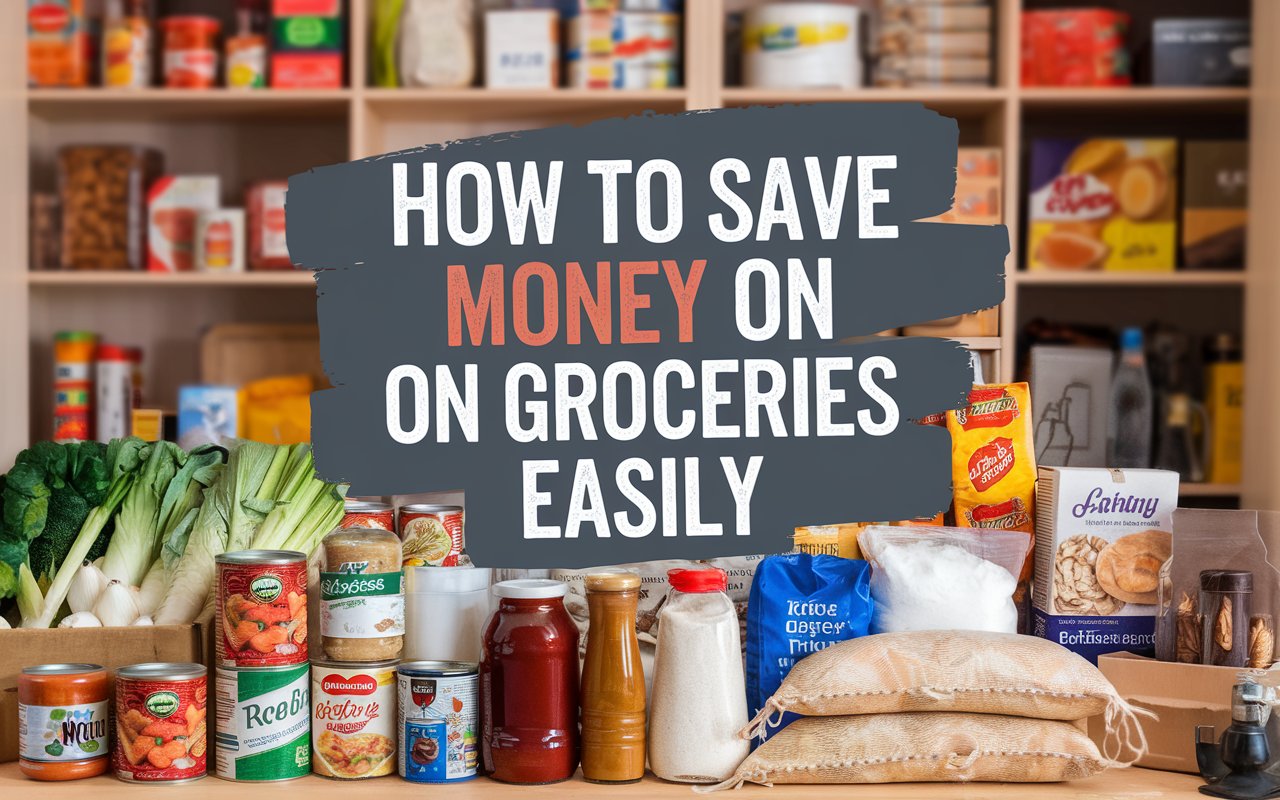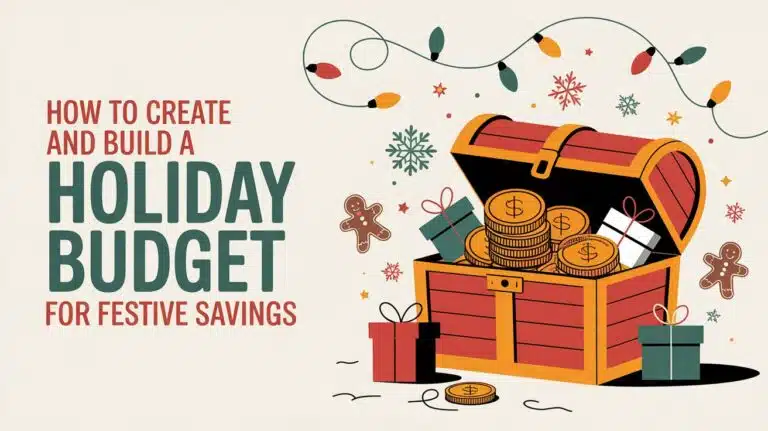Grocery shopping can be expensive. Many of us spend more than we need. But, saving money on groceries is easier than you think.
With a few simple tips, you can slash your grocery bill without sacrificing quality. Let’s dive into how you can cut costs and still enjoy delicious meals!
How Much Do People Spend on Groceries Each Month?
The amount people spend on groceries can vary widely depending on several factors like household size, eating habits, and location.
On average, a single adult might spend anywhere from $200 to $400 a month, while a family of four can easily rack up between $600 to $1,200 in grocery costs.
It’s staggering when you think about how much money goes toward food each year, especially when you realize there are ways to cut down those expenses without sacrificing quality or quantity.
According to the Bureau of Labor Statistics, the average American household spends about 10-12% of its income on groceries. That’s a significant portion of your monthly budget! I used to think grocery bills were just a part of life and that there wasn’t much I could do about it.
But as I started paying more attention to my shopping habits, I realized that many of my purchases were impulsive or poorly planned. That’s when I began researching and testing out strategies to cut down on my grocery spending.
Different studies have shown that with the right strategies, you can reduce your grocery expenses by 15-25%, sometimes even more. Imagine what you could do with those extra savings every month!
Whether you put it toward a vacation fund, pay down debt, or simply enjoy a bit more financial freedom, the impact can be significant. And the best part? These strategies are easy to implement.

30 Tips to Save Money on Groceries
I’ve compiled 30 of my favorite tips to save money on groceries. These aren’t just small, insignificant changes; they’re practical ways that can add up to big savings over time. Let’s dive into the strategies that have worked for me and many others!
1. Redefine Dinner
One of the easiest ways to save money is to rethink what “dinner” should look like. It doesn’t always have to be a fancy, elaborate meal. In fact, some of the most budget-friendly meals are the simplest ones.
Think about dishes like scrambled eggs with toast, a big salad loaded with veggies, or a hearty soup. These meals are often less expensive and still provide all the nutrition you need.
I’ve found that cutting down on complicated recipes has helped me save a lot on ingredients I don’t actually need. Plus, simpler meals mean less time in the kitchen!
Another great idea is to have breakfast for dinner. Pancakes, omelets, or oatmeal can make for a filling and budget-friendly dinner. They’re usually quick to prepare, and the ingredients are inexpensive. When you start thinking outside the box about what a “dinner” should be, you’ll notice your grocery bill dropping.
2. Crunch Some Numbers While You Shop
Doing quick math while you shop can save you from spending more than you should. I like to use the calculator on my phone to keep a running tally of how much I’m spending as I put items in my cart. This helps me stay aware of how much I’m spending and makes it easier to stick to my budget.
Some stores have those handy price scanners that allow you to check the cost of items before you get to the register. If you’re unsure about the price of something, double-check it to avoid surprises at the checkout. By keeping track of your total, you’re less likely to overspend and more likely to make conscious choices.
3. Round Up Your Grocery Cost Estimates
Rounding up your costs is a sneaky way to stay under budget. If an item is priced at $4.75, I mentally round it up to $5. This way, you build in a buffer, and when you reach the register, you’ll often find that your total is lower than what you estimated. It’s a small mental trick, but it can prevent those “uh-oh” moments when your total is higher than expected.
This method also gives you a little extra wiggle room for unexpected costs, like when you realize you need an extra ingredient or you decide to treat yourself to something small. It’s a simple trick, but over time, it can really help with budgeting.
4. Raid Your Pantry
Before you head to the store, take a good look at what you already have in your pantry and fridge. You might be surprised at how many meals you can create with ingredients you already own.
I’ve found that by “shopping” my pantry first, I can often stretch my groceries and avoid buying things I don’t need. It’s a great way to use up those canned goods or pasta that have been sitting there for a while.
I like to make a game out of it by seeing how many meals I can create with just the ingredients I already have. It forces me to be creative and think outside the box, and it’s a great way to cut down on waste. Plus, it helps you avoid buying duplicates of things you already have at home.
5. Think Before You Buy in Bulk
Buying in bulk can seem like a great way to save money, but it’s not always the best option. Before you buy a huge pack of something, think about whether you’ll actually use it all before it goes bad.
I’ve made the mistake of buying large quantities of perishables, only to throw half of it away because it expired before I could use it. For non-perishables like rice, beans, and pasta, bulk buying can be a great deal. But for fresh produce or dairy, it’s important to be cautious.
One trick I use is to ask myself if I can freeze part of the bulk item. If the answer is yes, then I go ahead and buy it in bulk. But if it’s something that won’t last long, I opt for a smaller quantity to avoid wasting both food and money.
6. Know When to Shop
Timing your grocery trips can make a big difference in how much you spend. Shopping in the middle of the week, when stores restock and aren’t as crowded, can lead to fresher produce and sometimes lower prices. Also, many stores mark down items toward the end of the day or near closing time to make room for new stock.
I’ve found that shopping later in the evening is a great way to find deals, especially on bakery items or perishable goods that are about to hit their expiration dates. You can get these items at a fraction of the cost, and as long as you plan to use them quickly or freeze them, it’s a great way to save.
7. Start Freezing and Storing Meals Now
Freezing meals has been a game-changer for me when it comes to saving both time and money. I like to batch-cook meals like soups, casseroles, or pasta sauces and freeze them for later. This way, when I have a busy day and don’t feel like cooking, I have a ready-to-go meal in the freezer. It also means I can buy ingredients in bulk and use them across multiple meals.
I also freeze leftovers instead of letting them go to waste. Even small portions of food can be frozen and enjoyed later, and it helps reduce food waste while also saving you from having to cook every single day. Just make sure to label and date everything, so you know what you have on hand!
8. Pay with Cash
Paying with cash is one of the best ways to stick to a budget. When you shop with a credit card, it’s easy to overspend because you’re not physically handing over money. With cash, you can only spend what you have in your wallet. I’ve found that using cash makes me more mindful of my purchases and helps me avoid impulse buys.
Set a cash budget for your groceries before you leave the house. If you’ve budgeted $100 for groceries, take only $100 in cash with you. It forces you to stick to your list and make smarter choices. Plus, you’ll feel great when you leave the store knowing you didn’t overspend!
9. Make a Meal Plan
Meal planning has been a huge money-saver for me. By planning out my meals for the week, I can create a grocery list of exactly what I need and avoid buying unnecessary items. It also helps me make the most of the ingredients I already have, which cuts down on food waste.
I usually sit down on Sundays and plan out what I’ll cook for the week. I take into account what’s on sale and what I already have in the pantry. This helps me create a list of only the items I need, and I stick to that list when I go shopping. Meal planning also reduces the temptation to eat out because I know I have all the ingredients I need for a delicious, home-cooked meal.
10. Stop Paying for Convenience
Pre-packaged, pre-cut, and pre-shredded items might save you time, but they often cost more than buying whole ingredients and preparing them yourself. For example, buying a block of cheese and shredding it yourself is usually cheaper than buying pre-shredded cheese. Similarly, whole vegetables are often less expensive than pre-cut ones.
I’ve found that taking a little extra time to prepare ingredients myself has saved me a lot of money. It’s also healthier because pre-packaged items often come with added preservatives. I like to set aside some time on Sundays to prep my ingredients for the week. It might take an hour or two, but the savings are worth it!
11. Avoid Impulse Buys
One of the biggest culprits of overspending at the grocery store is impulse buying. Stores are designed to encourage impulse purchases, with tempting snacks and treats placed strategically near the checkout. I’ve fallen into this trap more times than I can count!
To avoid impulse buys, I stick to my grocery list and remind myself of my budget. If I see something tempting that wasn’t on my list, I ask myself if I really need it. Nine times out of ten, the answer is no. If you have a hard time resisting, consider shopping online for groceries, where it’s easier to stick to your list.
12. Keep Track of Your Receipts
Saving your grocery receipts is a great way to track your spending and look for areas where you can cut back. I like to keep a folder of my grocery receipts so I can review them at the end of the month. This helps me see where my money is going and identify any patterns in my spending.
I also use apps like Ibotta and Fetch Rewards to scan my receipts for cashback offers. It’s a simple way to earn a little money back on your purchases, and over time, it adds up. Keeping track of your receipts also helps you stay accountable and mindful of your grocery budget.
13. Buy in Bulk (But Be Smart About It)
Buying in bulk can be a great way to save money, especially on non-perishable items like rice, pasta, and canned goods. However, it’s important to be smart about what you buy in bulk. I’ve learned the hard way that buying perishable items in bulk often leads to wasted food and money.
If you’re buying perishable items in bulk, make sure you have a plan to use them before they go bad. I like to freeze meats and bread that I buy in bulk, so I can use them over time without worrying about spoilage. Bulk buying is also a great way to save on household items like paper towels and cleaning supplies, which don’t expire.
14. Shop at Discount Stores
Discount stores like Aldi, Lidl, or local grocery outlets can offer significant savings compared to traditional supermarkets. I used to think discount stores didn’t carry quality products, but I was pleasantly surprised when I gave them a try. Many discount stores carry fresh produce, organic items, and even name-brand products at a fraction of the cost.
I’ve made discount stores a regular part of my shopping routine, and the savings have been substantial. It’s worth checking out different stores in your area to see where you can find the best deals. Just be open-minded and willing to try out new brands—you might find that you like them just as much as the pricier options!
15. Compare Prices at Different Stores
Not all grocery stores price items the same way, and comparing prices between stores can lead to big savings. I like to shop at multiple stores depending on what’s on sale. For example, I might buy my produce at a local farmers’ market, my pantry staples at a discount store, and my specialty items at a traditional supermarket.
It might take a little extra time, but shopping at different stores based on what they offer at the best prices can save you a lot in the long run. Many stores also offer price-matching, so if you find a lower price at a competitor, you can get that same price without having to visit multiple stores.
16. Shop the Perimeter of the Store
The outer edges of the grocery store are typically where you’ll find the freshest and most affordable items like produce, meat, dairy, and bread. I’ve found that shopping primarily in these areas helps me stick to healthier, whole foods, and avoid processed, expensive snacks that are usually found in the center aisles.
I like to start my grocery trips by filling my cart with fresh fruits, vegetables, and proteins. Once I’ve covered the perimeter, I only venture into the center aisles for specific items like pasta or canned goods. This strategy not only saves money but also encourages healthier eating habits.
17. Grow Your Own Herbs and Vegetables
Growing your own herbs and vegetables is a fun and rewarding way to save money on groceries. Even if you don’t have a lot of space, you can grow herbs like basil, cilantro, and parsley in small pots on a windowsill or balcony. These herbs can add fresh flavor to your meals and save you from buying expensive bunches at the store.
If you have a little more space, consider growing easy-to-care-for vegetables like tomatoes, lettuce, and peppers. I started a small garden in my backyard, and it’s been a great way to cut down on produce costs during the growing season. Plus, there’s nothing quite like eating food you grew yourself!
18. Use a Grocery List App
Using a grocery list app can help you stay organized and on track while shopping. I like to use apps like AnyList or Mealime to plan my meals and create a grocery list that I can easily check off as I shop. These apps also let you share your list with family members, so you can make sure you’re not doubling up on items.
Another great feature of these apps is that they allow you to save recipes and automatically generate a shopping list based on the ingredients you need. This helps you avoid impulse buys and ensures that you have everything you need for your planned meals.
19. Cut Down on Meat
Meat can be one of the most expensive items on your grocery list, so cutting down on how much meat you buy can lead to big savings. I’ve started incorporating more plant-based meals into my weekly routine, and not only has it saved me money, but it’s also been a great way to explore new recipes and flavors.
There are plenty of delicious and filling meatless meals you can try, like vegetable stir-fries, bean-based soups, or pasta with marinara sauce. If you’re not ready to go completely meatless, try having one or two meatless days a week. You’ll still enjoy your favorite meat dishes while cutting down on costs.
20. Look for Store Brands
Store-brand products are often just as good as name-brand items, but they come at a lower price. I used to be a bit skeptical about store brands, but after trying a few, I realized that they’re often just as high-quality as the more expensive alternatives.
Items like pasta, canned goods, cereal, and dairy products are great to buy as store brands. In fact, some store-brand products are made by the same manufacturers as name-brand products, but they’re sold at a lower price because they don’t carry the big brand name. It’s an easy way to save money without sacrificing quality.
21. Use Cashback Apps
There are several apps that offer cashback on your grocery purchases, and using them can save you a few dollars each trip. Apps like Ibotta, Checkout 51, and Rakuten allow you to earn cashback on items you already plan to buy. All you have to do is upload your receipt after shopping, and you’ll get money back on qualifying purchases.
It’s a simple way to save a little extra without much effort. Over time, those small amounts add up, and you can redeem your cashback for gift cards or direct deposits into your bank account. I’ve saved hundreds of dollars just by using these apps regularly.
22. Avoid the Bakery Section
As tempting as fresh-baked bread and pastries might be, they’re often much more expensive than the pre-packaged versions you can find in other aisles. I used to buy fresh bread from the bakery every week, but I realized that it was costing me a lot more than buying bread from the bread aisle.
Now, I opt for pre-packaged bread or even bake my own at home. Baking bread is surprisingly easy, and it can save you a lot of money in the long run. Plus, homemade bread tastes amazing, and you can customize it to your liking by adding herbs, seeds, or other ingredients.
23. Don’t Shop Hungry
Shopping when you’re hungry is one of the easiest ways to overspend. When I shop on an empty stomach, everything looks delicious, and I end up buying way more than I need. Studies have shown that hunger can lead to impulse buying, especially when it comes to junk food and snacks.
To avoid this, I make sure to eat a meal or snack before heading to the grocery store. When you’re not hungry, it’s easier to stick to your list and make more rational decisions about what to buy. You’ll be less tempted by those impulse purchases that can quickly add up.
24. Check Unit Prices
Unit prices are the price per ounce, pound, or other unit of measurement, and they can help you determine which item is the better deal. I always check the unit price on the shelf tag to compare similar products.
Sometimes the larger package might seem like a better deal, but the unit price reveals that the smaller package is actually cheaper.
Being aware of unit prices has saved me a lot of money, especially when comparing name-brand and store-brand items. It’s a simple way to make sure you’re getting the most value for your money, and over time, those savings really add up.
25. Stick to a Shopping Routine
One of the easiest ways to control grocery spending is to establish a regular shopping routine. I’ve found that shopping on the same day each week keeps me organized and helps me avoid unnecessary trips to the store. When I stick to a routine, I’m less likely to forget things or make multiple trips, which always ends up costing more.
In addition, I set a weekly budget for groceries and do my best to stay within it. Knowing how much I’m going to spend ahead of time makes the process less stressful and helps me avoid overspending. Once I got into the habit of shopping at consistent times, I noticed a significant improvement in how much I was saving each month.
26. Eat Before You Shop
This might sound simple, but it really works! I never shop on an empty stomach because hunger can make everything in the store look irresistible. I’ve noticed that I’m more likely to buy snacks or extra items that I don’t need when I’m hungry.
Now, I make sure to eat a meal or at least a snack before heading to the grocery store. This way, I stay focused on my list and avoid those impulse purchases. If you find yourself tempted by those goodies in the store, this tip can really help keep you on track and within budget.
27. Watch for Clearance Deals
Stores often have clearance sections or markdowns on items that are close to their expiration date, but that doesn’t mean the food is bad. I’ve scored great deals on bread, dairy products, and even meat that just needed to be used or frozen within a few days. Shopping for these clearance items is a great way to save money if you’re flexible with your meal planning.
I’ve found that if you shop early in the morning or late in the evening, you’re more likely to find these markdowns. This is one of the easiest ways to save on items that you’d normally pay full price for.
28. Use Coupons Wisely
Coupons can save you a lot of money if you use them wisely. However, I’ve learned that it’s important to only use coupons for things you actually need. It’s easy to get caught up in the excitement of a good deal and end up buying something you wouldn’t normally purchase.
I like to combine coupons with sales for even bigger savings. Many stores also offer digital coupons through their apps, so I make sure to check those before heading out to shop. By using coupons strategically, I can save on the items I already plan to buy.
29. Avoid Pre-Packaged Meals
Pre-packaged or frozen meals might seem convenient, but they’re often more expensive than cooking from scratch. I used to buy frozen dinners for busy nights, but I quickly realized that they were costing me much more than making my own meals at home.
Now, I prepare meals in advance and freeze them for those nights when I don’t feel like cooking. It’s cheaper and healthier, and I always have something ready to go. By skipping the pre-packaged meals, I’ve cut down on my grocery bill and improved the quality of my meals.
30. Don’t Shop with Kids
I love my kids, but shopping with them can lead to a much higher grocery bill. They always seem to find snacks, cereals, or treats that weren’t on the list. And, as much as I try to say no, I often give in.
Whenever possible, I try to shop alone or with my spouse. This way, I can focus on sticking to the list and budget without distractions. If I do have to bring the kids along, I set clear expectations before we go, and I let them pick out one small treat so they feel included without going overboard.
More tips for Life Hacks to Save Money in 2024.
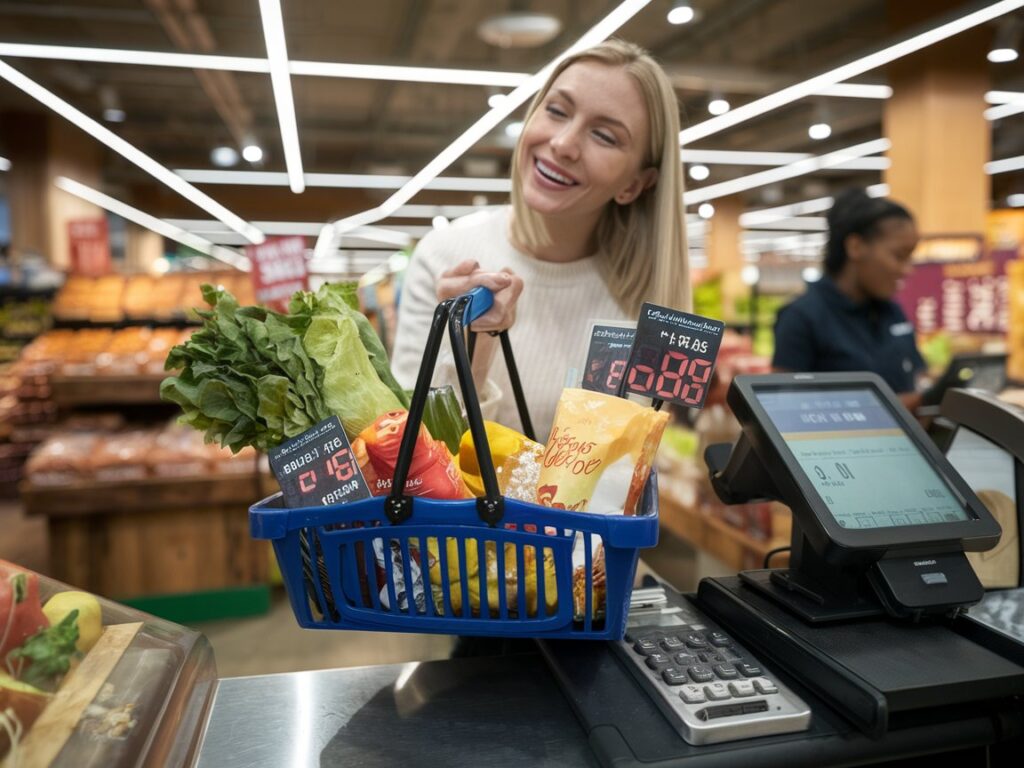
Grocery Shopping on a Budget Doesn’t Have to Be Hard
Saving money on groceries doesn’t have to feel overwhelming or complicated. With a few simple changes, you can significantly reduce your grocery bill and make smarter choices for your family.
From meal planning and shopping with a list to using coupons and shopping at discount stores, there are plenty of ways to cut costs without sacrificing quality.
The key is to be mindful of your spending and stick to a routine that works for you. It might take some time to adjust, but once you get into the habit of these money-saving strategies, you’ll start to see the benefits.
Grocery shopping doesn’t have to be a stressful experience—it can be an opportunity to save money and plan delicious, healthy meals for your family.
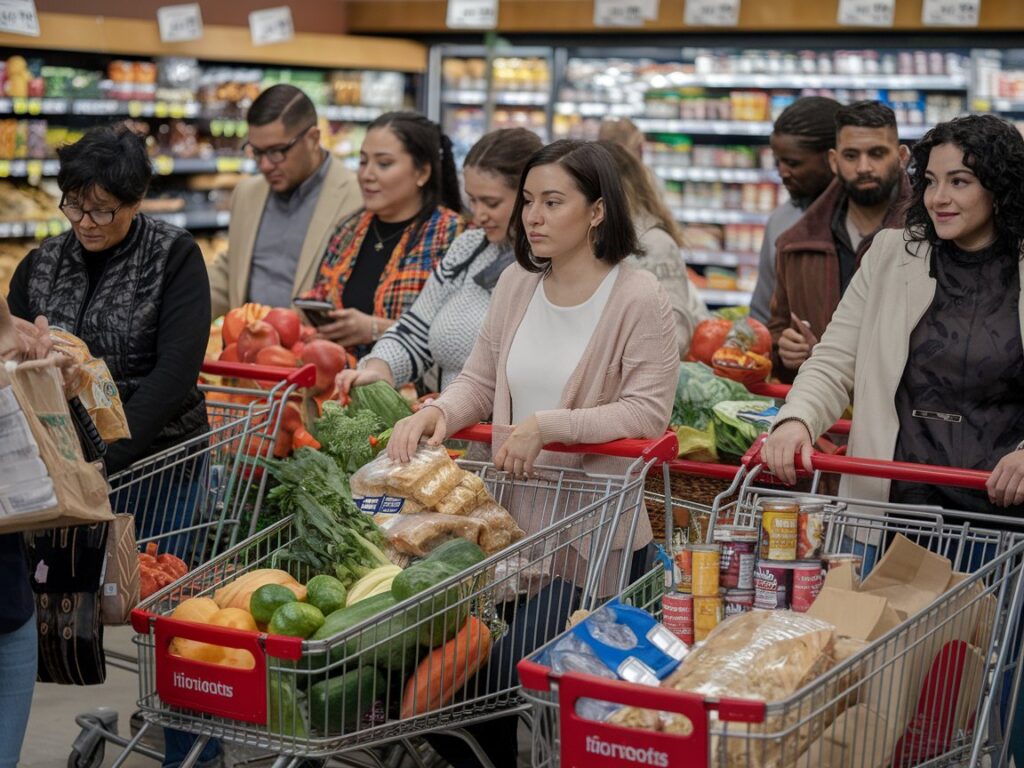
How These Tips Helped Me Save Big
I used to spend a lot on groceries. Every week, I would go to the store without a plan and just grab whatever looked good.
My bill would skyrocket, and I didn’t even realize it. One day, I decided to track how much I was spending, and I was shocked!
That’s when I started looking for ways to save. I began making a meal plan and sticking to a grocery list.
I also started comparing prices and shopping at different stores. The results were incredible. I was saving at least $50 a week by following just a few of these tips.
One of my favorite hacks is buying in bulk and freezing meals. I used to throw away so much food, but now I freeze it and save it for later.
I also started shopping in season, which made a big difference. Fresh fruits and vegetables taste better and cost less when they’re in season.
Now, grocery shopping feels like a game. I enjoy finding ways to save, and it’s rewarding to see how much less I spend. Plus, I’m still eating the foods I love, just in a smarter way!
More tips for DIY Home Repairs to Save Money.
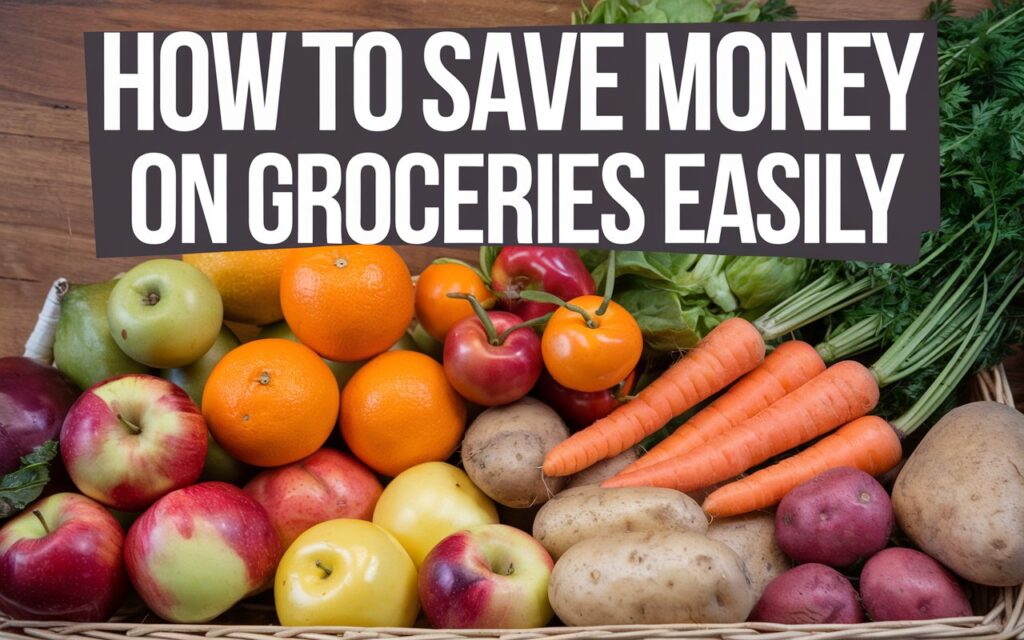
FAQs About Save Money on Groceries Easily
Key Takeaways
- Planning is key: Having a meal plan and a shopping list can save you from buying unnecessary items.
- Shop smarter: Know when to shop, how to avoid impulse buys, and which items to prioritize.
- Take advantage of sales: Timing your purchases with sales and discounts can lead to huge savings.
- Small changes add up: Each little tip, from buying in bulk to using apps, can lead to significant savings over time.
Saving money on groceries is all about planning ahead, making smart decisions, and staying consistent.
It’s not about sacrificing quality or buying less—it’s about being mindful of where your money is going and finding ways to cut costs where you can.
By using these 30 tips, you’ll be well on your way to slashing your grocery bill and making your budget go further.
Whether you start meal planning, shop the perimeter of the store, or simply stick to a shopping list, each small change can add up to big savings.
I’ve found that by focusing on these strategies, I’m able to enjoy the process of grocery shopping more and feel good about the money I’m saving.
So give it a try and see how much you can save on your next grocery run!
